The Ruby-Throated Hummingbird (Archilochus colubris) is a captivating jewel of the avian world, renowned for its vibrant plumage and remarkable behaviors.
Measuring a mere 3 to 3.5 inches in length, this diminutive bird boasts an iridescent green coat, with the male showcasing a brilliant ruby-red throat during the breeding season.
A master of agile flight, it can hover in mid-air, fly backward, and navigate with unparalleled precision. These tiny marvels embark on an extraordinary migratory journey, traversing the Gulf of Mexico to winter in Central America.
Their feeding habits, primarily sustained by nectar from vibrant flowers, make them vital pollinators. Nesting intricacies and solitary nature add layers to their intriguing life history.
The Ruby-Throated Hummingbird, with its seasonal presence and dazzling displays, stands as a testament to the awe-inspiring wonders nestled within the delicate world of birds.
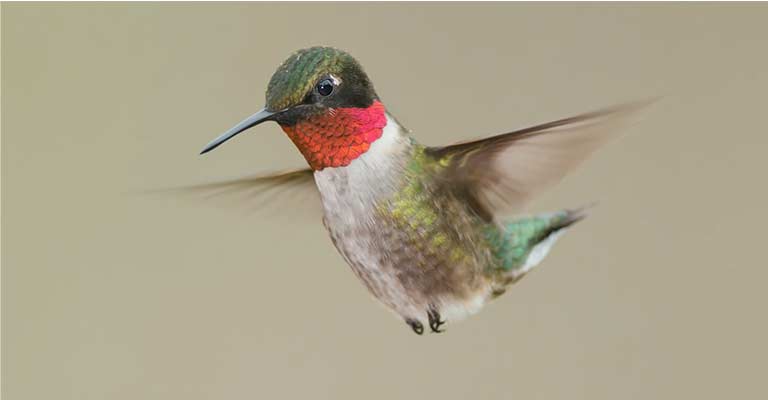
Identifying Characteristics of Ruby-Throated Hummingbird
The Ruby-throated Hummingbird (Archilochus colubris) is a dazzling and distinctive bird species known for its vibrant colors and remarkable characteristics.
Identifying this particular hummingbird involves paying attention to various key features that set it apart from other species.
Here are eight characteristics to help you identify the Ruby-throated Hummingbird:
Size and Shape
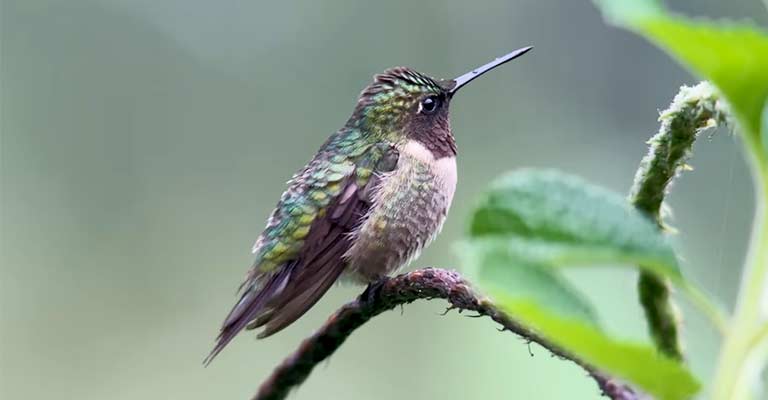
The Ruby-throated Hummingbird is a small bird, measuring around 3 to 3.5 inches in length with a wingspan of 3 to 4 inches. Its compact size and slender body make it distinct from larger hummingbird species.
Coloration
The male Ruby-throated Hummingbird boasts iridescent green plumage on its upperparts and a vivid ruby-red throat (gorget), which is its most striking feature.
In contrast, the female has a more subdued appearance, with green upperparts and a white throat.
Bill Shape
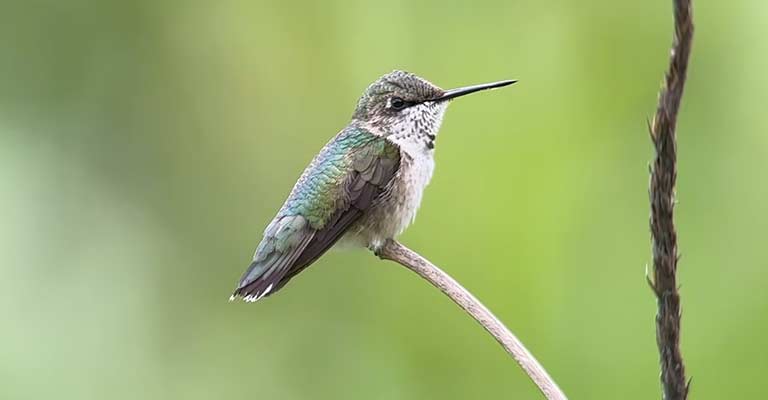
The bird’s bill is straight and slender, perfectly adapted for feeding on nectar from flowers. The length of the bill aids in reaching deep into tubular blossoms, a characteristic unique to hummingbirds.
Flight Pattern
Ruby-throated Hummingbirds exhibit agile and acrobatic flight patterns, capable of hovering in mid-air and even flying backward.
Their rapid wing beats, averaging 50 to 80 beats per second, distinguish them from other bird species.
Vocalizations
Listen for the distinct vocalizations of the Ruby-throated Hummingbird. Their calls are high-pitched and can be described as a series of sharp chips or chirps.
These vocalizations are often heard during territorial displays and interactions with other hummingbirds.
Migratory Behavior
Ruby-throated Hummingbirds are known for their remarkable migratory journeys.
They are the only hummingbird species that breeds in eastern North America and then migrates to Central America for the winter. Observing their migratory behavior can aid in identification.
Feeding Habits
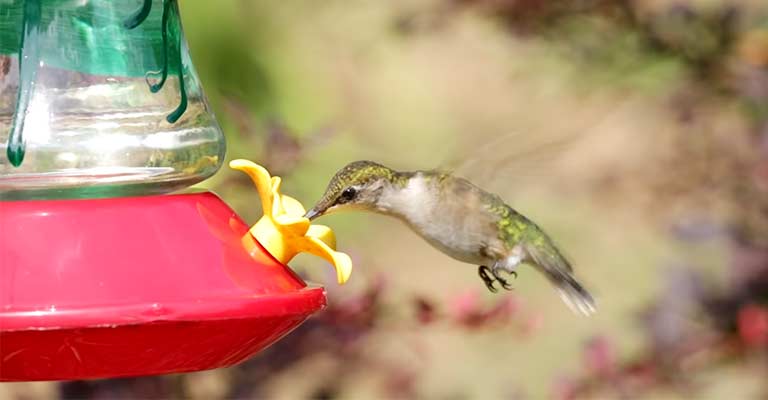
As nectar feeders, Ruby-throated Hummingbirds have a specialized diet. They also consume small insects and spiders for protein.
Identifying them at feeders with sugar water or by observing their foraging behavior among flowers can be a key clue.
Habitat Preferences
These hummingbirds prefer a variety of habitats, including gardens, woodlands, and meadows. They are often seen near flowering plants, where they can easily access nectar.
Understanding their habitat preferences can assist in narrowing down the potential species.
Recognizing the Ruby-throated Hummingbird involves a combination of visual and auditory cues.
From the vibrant red throat of the male to their distinctive flight patterns and migratory behavior, these characteristics make the Ruby-throated Hummingbird a fascinating and easily identifiable species in the world of birds.
Taxonomy of Ruby-Throated Hummingbird
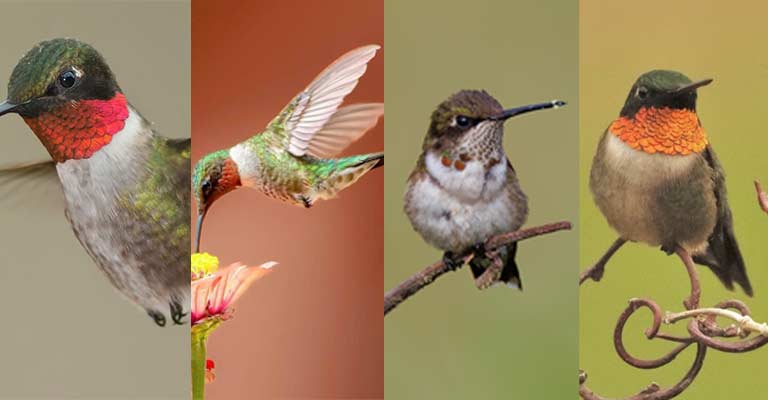
Here’s a table summarizing the taxonomy details of the Ruby-Throated Hummingbird (Archilochus colubris):
| Taxonomic Level | Classification |
| Domain | Eukaryota |
| Kingdom | Animalia |
| Phylum | Chordata |
| Class | Aves |
| Clade | Strisores |
| Order | Apodiformes |
| Family | Trochilidae |
| Genus | Archilochus |
| Species | A. colubris |
The Ruby-Throated Hummingbird (Archilochus colubris) belongs to the Animalia kingdom, Chordata phylum, and Aves class.
It is part of the Strisores clade, Apodiformes order, and Trochilidae family. The genus is Archilochus, and the specific species is A. colubris.
Within the intricate web of life, this hummingbird’s taxonomy places it among the diverse and fascinating avian species, emphasizing its classification from broader biological groups down to its unique species identifier.
Ruby-Throated Hummingbird Life History
The Ruby-throated Hummingbird (Archilochus colubris) is a captivating and diminutive bird that holds a special place in the avian world.
Its life history unfolds as a fascinating tale of migration, intricate nesting behaviors, and reliance on nectar-rich blooms.
Let’s check out the key aspects that define its existence, from feeding habits to nesting intricacies, and discuss conservation efforts aimed at preserving this enchanting species.
Food
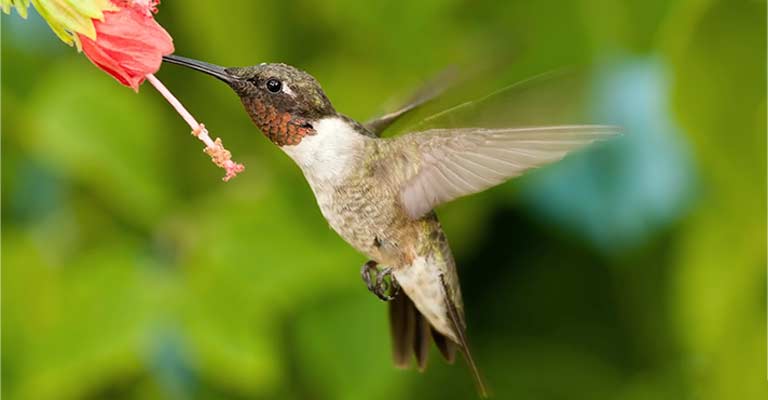
The primary source of sustenance for the Ruby-throated Hummingbird is nectar extracted from flowers.
With their specialized bills and long, extendable, tube-like tongues, these hummingbirds can access the deepest recesses of tubular blossoms.
While nectar serves as their main energy source, they also supplement their diet with small insects and spiders, providing essential proteins and nutrients.
Habitat
Ruby-throated Hummingbirds exhibit a diverse range of habitat preferences. They are commonly found in deciduous and mixed woodlands, gardens, meadows, and areas with abundant flowering plants.
These birds are particularly attracted to landscapes with a variety of blooming flowers, ensuring a steady supply of nectar throughout the breeding season.
Range Map

The Ruby-throated Hummingbird’s range spans across eastern North America, extending from southern Canada to the Gulf of Mexico. Their breeding grounds cover a broad region, including the eastern and central United States.
As migratory birds, they embark on an incredible journey across the Gulf of Mexico to winter in Central America, primarily in regions such as Mexico and Panama.
Nesting
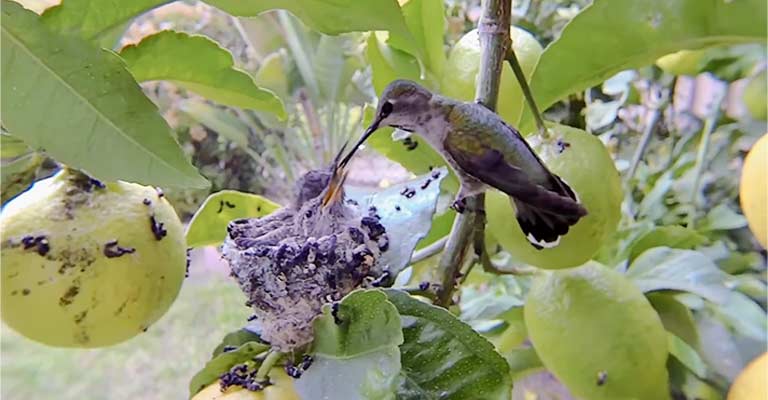
The nesting behaviors of the Ruby-throated Hummingbird are intricate and fascinating. The female constructs a cup-shaped nest made of plant material, bound together with spider silk.
These nests are often camouflaged with lichens and placed on horizontal branches for concealment. The tiny size of the nests reflects the diminutive stature of the bird itself.
Here’s a table summarizing the nesting details of the Ruby-throated Hummingbird:
| Nesting Details | Information |
| Clutch Size | Usually 2 eggs, occasionally 1 |
| Number of Broods | Typically 1 per breeding season |
| Egg Length | Approximately 1.0 cm (0.4 inches) |
| Egg Width | Around 0.5 cm (0.2 inches) |
| Incubation Period | 12 to 16 days |
| Nestling Period | 18 to 22 days |
| Egg Description | White, elliptical-shaped |
| Nest Location | Horizontal branches, well camouflaged |
| Nest Composition | Plant material bound with spider silk |
| Nest Size | About 1.3 to 2 inches in diameter |
| Parental Care | Female incubates and cares for chicks |
Breeding
Breeding season for Ruby-throated Hummingbirds typically spans from late spring to early summer. Males engage in elaborate courtship displays to attract females, showcasing their vibrant plumage and performing aerial acrobatics.
Once a mate is chosen, the female takes sole responsibility for incubating the eggs and raising the chicks.
Diseases and Treatment
While these resilient birds face threats from diseases such as avian influenza and parasitic infections, the most common maladies are related to feeders.
Maintaining clean and hygienic feeders is crucial to prevent the spread of pathogens. Regular cleaning with a solution of one part white vinegar to four parts water helps in keeping feeders free from harmful contaminants.
Conservation
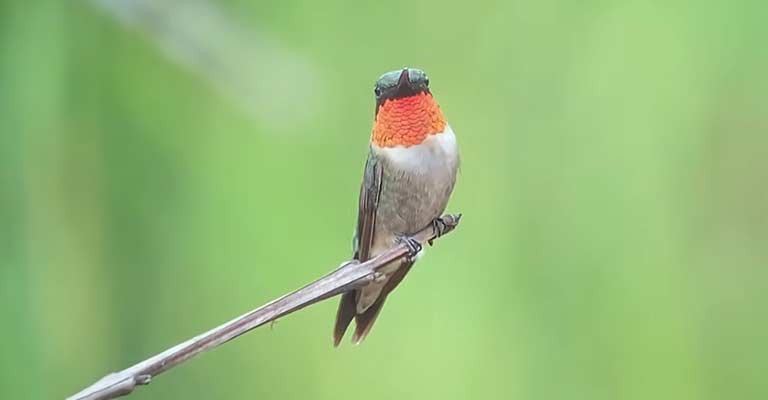
Conservation efforts for the Ruby-throated hummingbirds focus on preserving their natural habitats and ensuring the availability of suitable breeding grounds and migration routes.
Planting native flowering plants that provide nectar is encouraged to support their foraging needs.
Additionally, raising awareness about the impact of pesticides and the importance of maintaining a healthy ecosystem contributes to the overall conservation of this captivating species.
The life history of the Ruby-throated Hummingbird is a testament to the marvels of nature.
From their migratory feats to the delicate art of nest-building, understanding and appreciating the intricacies of their existence is paramount to ensuring the continued vibrancy of these enchanting birds in our world.
10 Fun Facts About Ruby-Throated Hummingbird
Here are 10 amazing fun facts about this beautiful bird, Ruby-Throated Hummingbird:
- Microscopic Marvel: The Ruby-throated Hummingbird is incredibly small, weighing just about 1/10th of an ounce. Despite their tiny size, these birds are known for their extraordinary feats, including long-distance migration.
- Heartbeat Hustle: Their hearts beat at an astonishing rate of 1,200 beats per minute when active. This rapid heartbeat is necessary to fuel their high metabolism, especially during flight and hovering.
- Fueling Up: To support their energy-intensive lifestyle, Ruby-throated Hummingbirds consume half their body weight in nectar daily. This translates to visiting hundreds of flowers and feeding up to 18 times per hour.
- Colorful Camouflage: The dazzling ruby-red throat (gorget) of the male is not a pigment but the result of iridescence. The microscopic platelets in their feathers refract light, creating the vibrant colors that change with the angle of view.
- Remarkable Migration: Despite their diminutive size, Ruby-throated Hummingbirds embark on an incredible migration journey. They cover about 500 miles non-stop across the Gulf of Mexico during their annual migration between breeding and wintering grounds.
- Aerial Acrobats: These hummingbirds are master aerial acrobats, capable of flying in all directions, including backward and upside down. Their agility and precision in flight are unmatched among birds.
- Territorial Tussles: Male Ruby-throated Hummingbirds are fiercely territorial and often engage in high-speed aerial battles to defend their feeding and nesting territories. These skirmishes involve dazzling displays of mid-air maneuvers.
- Nest Size Surprise: The female builds a nest about the size of a walnut, using materials like plant fibers, spider silk, and lichens. The exterior of the nest is camouflaged with lichens, making it blend seamlessly with the surrounding environment.
- Heartbeat Nap: To conserve energy during the night or when resting, Ruby-throated Hummingbirds go into a state of torpor, slowing down their heart rate and metabolism significantly. This energy-saving mode helps them survive periods of food scarcity.
- Insect Inclusion: While nectar is their primary food source, Ruby-throated Hummingbirds also consume small insects and spiders. This insect intake provides essential proteins and nutrients, complementing their nectar-based diet.
These fun facts highlight the remarkable and unique characteristics of the Ruby-throated Hummingbird, making it a fascinating subject of study and admiration among bird enthusiasts.
Wrapping Up
In the intricate tapestry of nature, the Ruby-throated Hummingbird emerges as a dazzling thread, weaving together vibrant colors, remarkable behaviors, and a captivating life history.
From their mesmerizing migratory feats to the delicacy of their tiny nests, these hummingbirds enchant with every beat of their rapid wings.
As stewards of the environment, understanding and appreciating the nuances of their existence becomes paramount for the conservation of this delightful species.
The Ruby-throated Hummingbird, with its microscopic marvels and seasonal symphony, stands as a testament to the awe-inspiring wonders that unfold in the world of avian beauty.